Community Response to Multiple Sound Sources: Integrating Acoustic and Contextual Approaches in the Analysis
Abstract
:1. Introduction
2. Methods
2.1. Area, Study Design and Sampling
2.2. Sound Exposure Assessment
2.3. Air Pollution Exposure Assessment
2.4. Questionnaire Information
2.5. Statistical Analysis
3. Results
3.1. Sociodemographic Sample Characteristics
3.2. Exposure Variables and Other Continuous Model Characteristics
3.3. Sound Source Exposure Response (ER) Models: Unadjusted
3.4. Sound Source Exposure Response Models: with Demographic/Health and Source Adjustments
3.4.1. Sound Source Exposure Response Models: with Total Annoyance (All Sources)
3.4.2. Sound Source Exposure Response Models: with Total High and Moderate Annoyance (Mixed Sources)
3.4.3. Sound Source Exposure Response Models: with Total High and Moderate Annoyance Related to Emergence Indicators
3.4.4. Sound Source Exposure Response Models: with Mutual Exposure of Another Source (Single Source High Annoyance)
3.4.5. Sound Source Exposure Response Models: with Total High and Moderate Annoyance at Night (All Sources)
3.5. Sound Source Exposure Response Models Including Contextual Variables
3.5.1. Highway Sound Exposure: Full Contextual Models with High Annoyance
3.5.2. Railway Sound Exposure: Full Contextual Models with High Annoyance
3.5.3. Main Road Models: Full Contextual Models with High Annoyance
3.6. Linear Full Regression Models with Continuous Annoyance Ratings: Mixed Sources
3.7. Total Exposure Response Models Including Contextual Variables: High and Moderate Annoyance
3.7.1. All Source Total Exposure Response Models Including Contextual Variables
3.7.2. Mixed Source Total Exposure Response Models Including Contextual Variables
3.7.3. Full Exposure Response Models with Contextual Variables: Using the Emergence Indicators
4. Discussion
5. Conclusions
Supplementary Materials
Acknowledgments
Author Contributions
Conflicts of Interest
References
- Lercher, P. Combined Noise Exposure at Home. Encycl. Environ. Health 2011, 764–777. [Google Scholar] [CrossRef]
- German Federal Environmental Agency. Multiple Sound Source Exposure. Available online: https://www.umweltbundesamt.de/themen/verkehr-laerm/laermwirkung/laermbelaestigung (accessed on 10 May 2017).
- Bristow, A.L.; Wardman, M.; Chintakayala, V.P.K. International meta-analysis of stated preference studies of transportation noise nuisance. Transportation 2015, 42, 71–100. [Google Scholar] [CrossRef]
- Fritschi, L.; Brown, L.; Kim, R.; Schwela, D.; Kephalopoulos, S. Burden of Disease from Environmental Noise—Quantification of Healthy Life Years Lost in Europe; WHO Regional Office for Europe: Bonn, Germany, 2011. [Google Scholar]
- Job, R.; Hatfield, J. Responses to noise from combined sources and regulation against background noise levels. In INTER-NOISE and NOISE-CON Congress and Conference Proceedings; Institute of Noise Control Engineering: The Hague, Holland, 2001; pp. 2190–2195. [Google Scholar]
- Miedema, H.M.E. Relationship between exposure to multiple noise sources and noise annoyance. J. Acoust. Soc. Am. 2004, 116, 949–957. [Google Scholar] [CrossRef] [PubMed]
- Botteldooren, D.; Verkeyn, A. Fuzzy models for accumulation of reported community noise annoyance from combined sources. J. Acoust. Soc. Am. 2002, 112, 1496–1508. [Google Scholar] [CrossRef] [PubMed]
- Marquis-Favre, C.; Premat, E.; Aubrée, D. Noise and its Effects A Review on Qualitative Aspects of Sound. Part II: Noise and Annoyance. Acta Acust. United Acust. 2005, 91, 626–642. [Google Scholar]
- Guski, R.; Felscher-Suhr, U.; Schuemer, R. The concept of noise annoyance: How international experts see it. J. Sound Vib. 1999, 223, 513–527. [Google Scholar] [CrossRef]
- Fields, J.M.; De Jong, R.G.; Gjestland, T.; Flindell, I.H.; Job, R.F.S.; Kurra, S.; Lercher, P.; Vallet, M.; Yano, T.; Guski, R. Standardized general-purpose noise reaction questions for community noise surveys: Research and a recommendation. J. Sound Vib. 2001, 242, 641–679. [Google Scholar] [CrossRef]
- Berglund, B.; Berglund, U.; Golstein, M.; Lindvall, T. Loudness (or annoyance) summation of combinded community noises. J. Acoust. Soc. Am. 1981, 70, 1628–1634. [Google Scholar] [CrossRef]
- Hatfield, J.; Job, R.; van Kamp, I. Clarifying “Soundscape”: Effects of Question Format on Reaction to Noise from Combined Sources. Acta Acust. United Acoust. 2006, 92, 922–928. [Google Scholar]
- Taylor, S.M. A comparison of models to predict annoyance reactions to noise from mixed sources. J. Sound Vib. 1982, 81, 123–138. [Google Scholar] [CrossRef]
- Alayrac, M.; Marquis-Favre, C.; Viollon, S. Total annoyance from an industrial noise source with a main spectral component combined with a background noise. J. Acoust. Soc. Am. 2011, 130, 189–199. [Google Scholar] [CrossRef] [PubMed]
- Brink, M.; Lercher, P. The effects of noise from combined traffic sources on annoyance: The interaction between aircraft and road traffic noise. In INTER-NOISE and NOISE-CON Congress and Conference Proceedings; Institute of Noise Control Engineering: Istanbul, Turkey, 2007; Volume 2007, pp. 2101–2108. [Google Scholar]
- Di, G.; Liu, X.; Lin, Q.; Zheng, Y.; He, L. The relationship between urban combined traffic noise and annoyance: An investigation in Dalian, north of China. Sci. Total Environ. 2012, 432, 189–194. [Google Scholar] [CrossRef] [PubMed]
- Danielsson, C.B.; Bodin, L.; Wulff, C.; Theorell, T. The relation between office type and workplace conflict: A gender and noise perspective. J. Environ. Psychol. 2015, 42, 161–171. [Google Scholar] [CrossRef]
- Öhrström, E.; Barregård, L.; Andersson, E.; Skånberg, A.; Svensson, H.; Ängerheim, P. Annoyance due to single and combined sound exposure from railway and road traffic. J. Acoust. Soc. Am. 2007, 122, 2642–2652. [Google Scholar] [CrossRef] [PubMed]
- Lam, K.-C.; Chan, P.-K.; Chan, T.-C.; Au, W.-H.; Hui, W.-C. Annoyance response to mixed transportation noise in Hong Kong. Appl. Acoust. 2009, 70, 1–10. [Google Scholar] [CrossRef]
- Hong, J.; Kim, J.; Kim, K.; Jo, Y.; Lee, S. Annoyance caused by single and combined noise exposure from air craft and road traffic. J. Temporal Des. Arch. Environ. 2009, 9, 137–140. [Google Scholar]
- Ragettli, M.; Goudreau, S.; Plante, C.; Perron, S.; Fournier, M.; Smargiassi, A. Annoyance from Road Traffic, Trains, Airplanes and from Total Environmental Noise Levels. Int. J. Environ. Res. Public Health 2015, 13, 90. [Google Scholar] [CrossRef] [PubMed]
- Kuhnt, S.; Schürmann, C.; Schütte, M.; Wenning, E.; Griefahn, B.; Vormann, M.; Hellbrück, J. Modelling Annoyance from Combined Traffic Noises: An Experimental Study. Acta Acust. United Acust. 2008, 94, 393–400. [Google Scholar] [CrossRef]
- Pierrette, M.; Marquis-Favre, C.; Morel, J.; Rioux, L.; Vallet, M.; Viollon, S.; Moch, A. Noise annoyance from industrial and road traffic combined noises: A survey and a total annoyance model comparison. J. Environ. Psychol. 2012, 32, 178–186. [Google Scholar] [CrossRef]
- Marquis-Favre, C.; Morel, J. A Simulated Environment Experiment on Annoyance Due to Combined Road Traffic and Industrial Noises. Int. J. Environ. Res. Public Health 2015, 12, 8413–8433. [Google Scholar] [CrossRef] [PubMed]
- Jeon, J.Y.; Lee, P.J. Effect of combined noise sources on cognitive performance and perceived disturbance. J. Acoust. Soc. Am. 2010, 127, 1802. [Google Scholar] [CrossRef]
- Vos, J. Annoyance caused by simultaneous impulse, road-traffic, and aircraft sounds: A quantitative model. J. Acoust. Soc. Am. 1992, 91, 3330–3345. [Google Scholar] [CrossRef] [PubMed]
- Morel, J.; Marquis-Favre, C.; Gille, L.-A. Noise annoyance assessment of various urban road vehicle pass-by noises in isolation and combined with industrial noise: A laboratory study. Appl. Acoust. 2016, 101, 47–57. [Google Scholar] [CrossRef]
- Klein, A.; Marquis-Favre, C.; Champelovier, P. Assessment of annoyance due to urban road traffic noise combined with tramway noise. J. Acoust. Soc. Am. 2017, 141, 231–242. [Google Scholar] [CrossRef] [PubMed]
- Gille, L.-A.; Marquis-Favre, C.; Morel, J. Testing of the European Union exposure-response relationships and annoyance equivalents model for annoyance due to transportation noises: The need of revised exposure-response relationships and annoyance equivalents model. Environ. Int. 2016, 94, 83–94. [Google Scholar] [CrossRef] [PubMed]
- Schomer, P.; Mestre, V.; Schulte-Fortkamp, B.; Boyle, J. Respondents’ answers to community attitudinal surveys represent impressions of soundscapes and not merely reactions to the physical noise. J. Acoust. Soc. Am. 2013, 134, 767–772. [Google Scholar] [CrossRef] [PubMed]
- Schomer, P.; Mestre, V.; Fidell, S.; Berry, B.; Gjestland, T.; Vallet, M.; Reid, T. Role of community tolerance level (CTL) in predicting the prevalence of the annoyance of road and rail noise. J. Acoust. Soc. Am. 2012, 131, 2772–2786. [Google Scholar] [CrossRef] [PubMed]
- Fidell, S.; Mestre, V.; Schomer, P.; Berry, B.; Gjestland, T.; Vallet, M.; Reid, T. A first-principles model for estimating the prevalence of annoyance with aircraft noise exposure. J. Acoust. Soc. Am. 2011, 130, 791–806. [Google Scholar] [CrossRef] [PubMed]
- Fields, J.M. Effect of personal and situational variables on noise annoyance in residential areas. J. Acoust. Soc. Am. 1993, 93, 2753. [Google Scholar] [CrossRef]
- Job, R.S.F. Community response to noise: A review of factors influencing the relationship between noise exposure and reaction. J. Acoust. Soc. Am. 1988, 83, 991–1001. [Google Scholar] [CrossRef]
- Flindell, I.H.; Stallen, P.J. M. Non-acoustical factors in environmental noise. Noise Health 1999, 1, 11–16. [Google Scholar] [PubMed]
- Guski, R. Personal and social variables as co-determinants of noise annoyance. Noise Health 1999, 1, 45–56. [Google Scholar] [PubMed]
- Miedema, H.M.E.; Vos, H. Noise sensitivity and reactions to noise and other environmental conditions. J. Acoust. Soc. Am. 2003, 113, 1492–1504. [Google Scholar] [CrossRef] [PubMed]
- Miedema, H.M.; Vos, H. Demographic and attitudinal factors that modify annoyance from transportation noise. J. Acoust. Soc. Am. 1999, 105, 3336–3344. [Google Scholar] [CrossRef]
- Lercher, P. Environmental noise and health: An integrated research perspective. Environ. Int. 1996, 22, 117–129. [Google Scholar] [CrossRef]
- Ascari, E.; Licitra, G.; Teti, L.; Cerchiai, M. Low frequency noise impact from road traffic according to different noise prediction methods. Sci. Total Environ. 2015, 505, 658–669. [Google Scholar] [CrossRef] [PubMed]
- Schomer, P. Criteria for assessment of noise annoyance. Noise Control. Eng. J. 2005, 53, 132–144. [Google Scholar] [CrossRef]
- Klein, A.; Marquis-Favre, C.; Weber, R.; Trollé, A. Spectral and modulation indices for annoyance-relevant features of urban road single-vehicle pass-by noises. J. Acoust. Soc. Am. 2015, 137, 1238–1250. [Google Scholar] [CrossRef] [PubMed]
- Lercher, P.; Bockstael, A.; De Coensel, B.; Dekoninck, L.; Botteldooren, D. The application of a notice-event model to improve classical exposure-annoyance estimation. J. Acoust. Soc. Am. 2012, 131, 3223. [Google Scholar] [CrossRef]
- Bockstael, A.; De Coensel, B.; Lercher, P.; Botteldooren, D. Influence of temporal structure of the sonic environment on annoyance. In Proceedings of the 10th International Congress on Noise as a Public Health Problem (ICBEN 2011); Griefahn, B., Ed.; Institute of Acoustics: London, UK, 2011; pp. 945–952. [Google Scholar]
- De Coensel, B.; Botteldooren, D.; De Muer, T.; Berglund, B.; Nilsson, M.E.; Lercher, P. A model for the perception of environmental sound based on notice-events. J. Acoust. Soc. Am. 2009, 126, 656–665. [Google Scholar] [CrossRef] [PubMed]
- Klæboe, R.; Engelien, E.; Steinnes, M. Context sensitive noise impact mapping. Appl. Acoust. 2006, 67, 620–642. [Google Scholar] [CrossRef]
- Lim, C.; Kim, J.; Hong, J.; Lee, S. Effect of background noise levels on community annoyance from aircraft noise. J. Acoust. Soc. Am. 2008, 123, 766–771. [Google Scholar] [CrossRef] [PubMed]
- De Kluizenaar, Y.; Janssen, S.; Vos, H.; Salomons, E.; Zhou, H.; van den Berg, F. Road Traffic Noise and Annoyance: A Quantification of the Effect of Quiet Side Exposure at Dwellings. Int. J. Environ. Res. Public Health 2013, 10, 2258–2270. [Google Scholar] [CrossRef] [PubMed]
- Veisten, K.; Smyrnova, Y.; Klæboe, R.; Hornikx, M.; Mosslemi, M.; Kang, J. Valuation of Green Walls and Green Roofs as Soundscape Measures: Including Monetised Amenity Values Together with Noise-attenuation Values in a Cost-benefit Analysis of a Green Wall Affecting Courtyards. Int. J. Environ. Res. Public Health 2012, 9, 3770–3788. [Google Scholar] [CrossRef] [PubMed]
- Ohrstrom, E.; Skanberg, A.; Svensson, H.; Gidlof-Gunnarsson, A. Effects of road traffic noise and the benefit of access to quietness. J. Sound Vib. 2006, 295, 40–59. [Google Scholar] [CrossRef]
- Lercher, P. Deviant dose-response curves for traffic noise in’sensitive areas’? In INTER-NOISE and NOISE-CON Congress and Conference Proceedings; Institute of Noise Control Engineering: Christchurch, New Zealand, 1998; Volume 1998, pp. 710–713. [Google Scholar]
- Lercher, P.; de Greve, B.; Botteldooren, D.; Rüdisser, J. A comparison of regional noise-annoyance-curves in alpine areas with the European standard curves. In Proceedings of the 9th International Congress on Noise as a Public Health Problem (ICBEN), Foxwoods, CT, USA, 21–25 July 2008; pp. 562–570. [Google Scholar]
- Molitor, R.; Käfer, A.; Thaller, O.; Samaras, Z.; Tourlou, P.M.; Ntziachristos, L.; Dom, A. Road Freight Transport and the Environment in Mountainous Areas; European Environment Agency: Copenhagen, Denmark, 2001. [Google Scholar]
- Kurze, U. Lärm im Alpenraum Durch Straßen- und Schienenverkehr; Müller BBM: Munich, Germany, 2001. [Google Scholar]
- Heutschi, K. On the sound propagation in alpine valleys. In Proceedings of Euronoise 2006; European Acoustics Association: Tampere, Finland, 2006. [Google Scholar]
- Jonasson, H. Acoustical source modelling of road vehicles. Acta Acust. United Acust. 2007, 93, 173–184. [Google Scholar]
- De Greve, B.; de Muer, T.; Botteldooren, D. Outdoor beam tracing over undulating terrain. In Proceedings of Forum Acusticum 2005; OPAKFI: Budapest, Hungary, 2005. [Google Scholar]
- De Greve, B.; van Renterghem, T.; Botteldooren, D. Outdoor sound propagation in moutainous areas: Comparison of reference and engineering models. In Proceedings of the 19th International Congress on Acoustics; ICA: Madrid, Spain, 2007. [Google Scholar]
- Van Renterghem, T.; Botteldooren, D.; Lercher, P. Comparison of measurements and predictions of sound propagation in a valley-slope configuration in an inhomogeneous atmosphere. J. Acoust. Soc. Am. 2007, 121, 2522–2533. [Google Scholar] [CrossRef] [PubMed]
- Heimann, D.; De Franceschi, M.; Emeis, S.; Lercher, P.; Seibert, P.P. Air Pollution, Traffic Noise and Related Health Effects in the Alpine Space: A Guide for Authorities and Consulters; Heimann, D., De Franceschi, M., Emeis, S., Lercher, P., Seibert, P., Eds.; Università degli Studi di Trento: Trento, Italy, 2007. [Google Scholar]
- Schäfer, K.; Vergeiner, J.; Emeis, S.; Wittig, J.; Hoffmann, M.; Obleitner, F.; Suppan, P. Atmospheric influences and local variability of air pollution close to a motorway in an Alpine valley during winter. Meteorol. Z. 2008, 17, 297–309. [Google Scholar] [CrossRef]
- Thudium, J. The air and noise situation in the alpine transit valleys of Fréjus, Mont-Blanc, Gotthard and Brenner. J. Alp. Res. Rev. Géogr. Alp. 2009, 43–51. [Google Scholar] [CrossRef]
- Heimann, D.; Schafer, K.; Emeis, S.; Suppan, P.; Obleitner, F.; Uhrner, U. Combined evaluations of meteorological parameters, traffic noise and air pollution in an Alpine valley. Meteorol. Z. 2010, 19, 47–61. [Google Scholar] [CrossRef]
- Almbauer, R.; Oettl, D.; Bacher, M.; Sturm, P. Simulation of the air quality during a field study for the city of Graz. Atmos. Environ. 2000, 34, 4581–4594. [Google Scholar] [CrossRef]
- Oettl, D.; Sturm, P.; Almbauer, R. Evaluation of GRAL for the pollutant dispersion from a city street tunnel portal at depressed level. Environ. Model. Softw. 2005, 20, 499–504. [Google Scholar] [CrossRef]
- Oettl, D.; Sturm, P.J.; Pretterhofer, G.; Bacher, M.; Rodler, J.; Almbauer, R.A. Lagrangian dispersion modeling of vehicular emissions from a highway in complex terrain. J. Air Waste Manag. Assoc. 2003, 53, 1233–1240. [Google Scholar] [CrossRef] [PubMed]
- Oettl, D.; Almbauer, R.A.; Sturm, P.J.; Pretterhofer, G. Dispersion modelling of air pollution caused by road traffic using a Markov Chain-Monte Carlo model. Stoch. Environ. Res. Risk Assess. 2003, 17, 58–75. [Google Scholar] [CrossRef]
- Oettl, D.; Almbauer, R.A.; Sturm, P.J. A new method to estimate diffusion in stable, low-wind conditions. J. Appl. Meteorol. 2001, 40, 259–268. [Google Scholar] [CrossRef]
- Oettl, D.; Goulart, A.; Degrazia, G.; Anfossi, D. A new hypothesis on meandering atmospheric flows in low wind speed conditions. Atmos. Environ. 2005, 39, 1739–1748. [Google Scholar] [CrossRef]
- Rexeis, M.; Hausberger, S. Trend of vehicle emission levels until 2020—Prognosis based on current vehicle measurements and future emission legislation. Atmos. Environ. 2009, 43, 4689–4698. [Google Scholar] [CrossRef]
- Romberg, E.; Bösinger, R.; Lohmeyer, A.; Ruhnke, R. NO-NO2-Umwandlungsmodell für die Anwendung bei Immissionsprognosen für Kfz-Abgase. Gefahrstoffe Reinhaltung Luft 1996, 56, 215–218. [Google Scholar]
- Seinfeld, J.; Pandis, S. Atmospheric Chemistry And Physics: From Air Pollution to Climate Change; John Wiley & Sons: New York, NY, USA, 1998. [Google Scholar]
- Botteldooren, D.; Lercher, P. Soft-computing base analyses of the relationship between annoyance and coping with noise and odor. J. Acoust. Soc. Am. 2004, 115, 2974–2985. [Google Scholar] [CrossRef] [PubMed]
- Diener, E.; Suh, E.M.; Lucas, R.E.; Smith, H.L. Subjective well-being: Three decades of progress. Psychol. Bull. 1999, 125, 276–302. [Google Scholar] [CrossRef]
- R Development Core Team. R: A Language and Environment for Statistical Computing. In R Founddtion for Statistical Computing; R Development Core Team: Vienna, Austria, 2016; ISBN 3-900051-07-0. [Google Scholar]
- Revelle, W. R-psych: Procedures for Personality and Psychological Research; Northwestern University: Evanston, US, 2017. [Google Scholar]
- Harrell, F.E., Jr. rms: Regression Modelling Strategies; Vanderbilt University: Nashville, TN, USA, 2016. [Google Scholar]
- Royston, P.; Sauerbrei, W. Multivariable Model—Building: A Pragmatic Approach to Regression Analysis based on Fractional Polynomials for Modelling Continuous Variables; John Wiley & Sons Ltd.: Chichester, UK, 2008. [Google Scholar]
- Harrell, F.E., Jr. Regression Modeling Strategies; Springer International Publishing: Cham, Switzerland, 2015. [Google Scholar]
- Hendrickx, J. Perturb 2012, Version 2.05. 2012.
- Belsley, D.A. A Guide to using the collinearity diagnostics. Comput. Sci. Econ. Manag. 1991, 4, 33–50. [Google Scholar]
- Schreurs, E.; Koeman, T.; Jabben, J. Low frequency noise impact of road traffic in the Netherlands. In Proceedings of Acoustics 08; European Acoustics Association: Paris, France, 2008; pp. 1943–1948. [Google Scholar]
- Takahashi, Y. Vibratory Sensation Induced by Low-Frequency Noise: A Pilot Study on the Threshold Level. Noise Notes 2010, 9, 21–30. [Google Scholar] [CrossRef]
- Takahashi, Y. Vibratory sensation induced by low-frequency noise: The threshold for “vibration perceived in the head” in normal-hearing subjects. J. Low Freq. Noise Vib. Act. Control. 2013, 32, 1–10. [Google Scholar] [CrossRef]
- Cik, M.; Lienhart, M.; Lercher, P. Analysis of Psychoacoustic and Vibration-Related Parameters to Track the Reasons for Health Complaints after the Introduction of New Tramways. Appl. Sci. 2016, 6, 398. [Google Scholar] [CrossRef]
- Lercher, P.; Brauchle, G.; Widmann, U. The interaction of landscape and soundscape in the Alpine area of the Tyrol: An annoyance perspective. In INTER-NOISE and NOISE-CON Congress and Conference Proceedings; Institute of Noise Control Engineering: Fort Lauderdale, FL, USA, 1999; Volume 1999, pp. 1347–1350. [Google Scholar]
- Guski, R.; Schreckenberg, D.; Schuemer, R. WHO Environmental Noise Guidelines for the European Region: A Systematic Review on Environmental Noise and Annoyance. Int. J. Environ. Res. Public Health 2017. submitted. [Google Scholar]
- Miedema, H.M.; Oudshoorn, C.G. Annoyance from transportation noise: Relationships with exposure metrics DNL and DENL and their confidence intervals. Environ. Health Perspect. 2001, 109, 409–416. [Google Scholar] [CrossRef] [PubMed]
- Morihara, T.; Sato, T.; Yano, T. Comparison of dose-response relationships between railway and road traffic noises: The moderating effect of distance. J. Sound Vib. 2004, 277, 559–565. [Google Scholar] [CrossRef]
- Lim, C.; Kim, J.; Hong, J.; Lee, S. The relationship between railway noise and community annoyance in Korea. J. Acoust. Soc. Am. 2006, 120, 2037–2042. [Google Scholar] [CrossRef] [PubMed]
- Lercher, P.; Schmitzberger, R.; Kofler, W. Perceived traffic air pollution, associated behavior and health in an alpine area. Sci. Total Environ. 1995, 169, 71–74. [Google Scholar] [CrossRef]
- Klaeboe, R.; Clench-Aas, J.; Bartonova, A.; Kolbenstvetd, M. Oslo traffic study—Part 1: An integrated approach to assess the combined effects of noise and air pollution on annoyance. Atmos. Environ. 2000, 34, 4727–4736. [Google Scholar] [CrossRef]
- Oiamo, T.H.; Luginaah, I.N.; Baxter, J. Cumulative effects of noise and odour annoyances on environmental and health related quality of life. Soc. Sci. Med. 2015, 146, 191–203. [Google Scholar] [CrossRef] [PubMed]
- Bodin, T.; Björk, J.; Ardö, J.; Albin, M. Annoyance, Sleep and Concentration Problems due to Combined Traffic Noise and the Benefit of Quiet Side. Int. J. Environ. Res. Public Health 2015, 12, 1612–1628. [Google Scholar] [CrossRef] [PubMed]
- Joncour, C.; Gautier, C.; Lambert, J. Annoyance due to combined noise sources. In Internoise 2000; INRETS: Nice, France, 2000; pp. 1033–1036. [Google Scholar]
- Champelovier, P.; Cremezi-Charlet, C.; Lambert, J. Assessment of Annoyance from Combined Exposure to Road and Rail Traffic Noises; Institut National de Recherche sur les Transports et leur Sécurité: Bron, France, 2003; pp. 1–150. [Google Scholar]
- Lercher, P.; Brink, M.; Rudisser, J.; Van Renterghem, T.; Botteldooren, D.; Baulac, M.; Defrance, J. The effects of railway noise on sleep medication intake: Results from the ALPNAP-study. Noise Health 2010, 12, 110–119. [Google Scholar] [CrossRef] [PubMed]
- Job, R.F.S.; Hatfield, J.; Carter, N.L.; Peploe, P.; Taylor, R.; Morrell, S. General scales of community reaction to noise (dissatisfaction and perceived affectedness) are more reliable than scales of annoyance. J. Acoust. Soc. Am. 2001, 110, 939–946. [Google Scholar] [CrossRef] [PubMed]
- Klæboe, R.; Kolbenstvedt, M.; Fyhri, A.; Solberg, S. The Impact of an Adverse Neighbourhood Soundscape on Road Traffic Noise Annoyance. Acta Acust. United Acoust. 2005, 91, 1039–1050. [Google Scholar]
- Tenailleau, Q.M.; Bernard, N.; Pujol, S.; Houot, H.; Joly, D.; Mauny, F. Assessing residential exposure to urban noise using environmental models: Does the size of the local living neighborhood matter&quest. J. Expo. Sci. Environ. Epidemiol. 2015, 25, 89–96. [Google Scholar] [PubMed]
- Trollé, A.; Marquis-Favre, C.; Parizet, É. Perception and Annoyance Due to Vibrations in Dwellings Generated From Ground Transportation: A Review. Low Freq. Noise Vib. Act. Control 2015, 34, 413–458. [Google Scholar] [CrossRef]
- Klaeboe, R.; Turunen-Rise, I.H.; Harvik, L.; Madshus, C. Vibration in dwellings from road and rail traffic—Part II: Exposure-effect relationships based on ordinal logit and logistic regression models. Appl. Acoust. 2003, 64, 89–109. [Google Scholar] [CrossRef]
- Klaeboe, R. Noise and Health: Annoyance and Interference. In Encyclopedia of Environmental Health; Nriagu, J.O., Ed.; Elsevier: Burlington, CA, USA, 2011; pp. 152–163. [Google Scholar]
- Waddington, D.C.; Woodcock, J.; Peris, E.; Condie, J.; Sica, G.; Moorhouse, A.T.; Steele, A. Human response to vibration in residential environments. J. Acoust. Soc. Am. 2014, 135, 182–193. [Google Scholar] [CrossRef] [PubMed]
- Claeson, A.-S.; Lidén, E.; Nordin, M.; Nordin, S. The role of perceived pollution and health risk perception in annoyance and health symptoms: A population-based study of odorous air pollution. Int. Arch. Occup. Environ. Health 2013, 86, 367–374. [Google Scholar] [CrossRef] [PubMed]
- Fyhri, A.; Klaboe, R. Road traffic noise, sensitivity, annoyance and self-reported health—A structural equation model exercise. Environ. Int. 2009, 35, 91–97. [Google Scholar] [CrossRef] [PubMed]
- Pennig, S.; Schady, A. Railway noise annoyance: Exposure-response relationships and testing a theoretical model by structural equation analysis. Noise Health 2014, 16, 388–399. [Google Scholar] [CrossRef] [PubMed]
- Von Lindern, E.; Hartig, T.; Lercher, P. Traffic-related exposures, constrained restoration, and health in the residential context. Health Place 2016, 39, 92–100. [Google Scholar] [CrossRef] [PubMed]
- Yano, T.; Sato, T.; Björkman, M.; Rylander, R. Comparison of community response to road traffic noise in japan and sweden—Part II: Path analysis. J. Sound Vib. 2002, 250, 169–174. [Google Scholar] [CrossRef]
- Oiamo, T.H.; Baxter, J.; Grgicak-Mannion, A.; Xu, X.; Luginaah, I.N. Place effects on noise annoyance: Cumulative exposures, odour annoyance and noise sensitivity as mediators of environmental context. Atmos. Environ. 2015, 116, 183–193. [Google Scholar] [CrossRef]
- Riedel, N.; Köckler, H.; Scheiner, J.; Berger, K. Objective exposure to road traffic noise, noise annoyance and self-rated poor health—Framing the relationship between noise and health as a matter of multiple stressors and resources in urban neighbourhoods. J. Environ. Plan. Manag. 2015, 58, 336–356. [Google Scholar] [CrossRef]
- Lercher, P.; Bockstael, A.; Dekoninck, L.; De Coensel, B.; Botteldooren, D. Can noise from a main road be more annoying than from highway? An environmental health and soundscape approach. In INTER-NOISE and NOISE-CON Congress and Conference Proceedings; Institute of Noise Control Engineering: Innsbruck, Austria, 2013; Volume 247, pp. 5908–5916. [Google Scholar]
- Schomer, P.D.; Wagner, L.R. On the contribution of noticeability of environmental sounds to noise annoyance. Noise Control Eng. J. 1996, 44, 294–305. [Google Scholar] [CrossRef]
- Roberts, M.; Western, A.; Webber, M. A theory of patterns of passby noise. J. Sound Vib. 2003, 262, 1047–1056. [Google Scholar] [CrossRef]
- Lercher, P. Straßenverkehr und Gesundheit, das Beispiel Lärmdorf. Veröffentlichungen der Universität Innsbruck 1988, 166, 27–48. [Google Scholar]
- Lercher, P.; Widmann, U. Der Beitrag verchiedener Akustik-Indikatoren fuer eine erweiterte Belaestigungsanalyse in einer komplexen akustischen Situation nach Laermschutzmafsnahmen. Fortschr. Akust. 1998, 24, 86–88. [Google Scholar]
- Pedersen, E.; Larsman, P. The impact of visual factors on noise annoyance among people living in the vicinity of wind turbines. J. Environ. Psychol. 2008, 28, 379–389. [Google Scholar] [CrossRef]
- Bangjun, Z.; Lili, S.; Guoqing, D. The influence of the visibility of the source on the subjective annoyance due to its noise. Appl. Acoust. 2003, 64, 1205–1215. [Google Scholar] [CrossRef]
- Hastie, T.; Tibshirani, R.; Friedman, J. The Elements of Statistical Learning, 2nd ed.; Springer: New York, NY, USA, 2009. [Google Scholar]
- Dormann, C.F.; Elith, J.; Bacher, S.; Buchmann, C.; Carl, G.; Carré, G.; Marquéz, J.R.G.; Gruber, B.; Lafourcade, B.; Leitão, P.J.; et al. Collinearity: A review of methods to deal with it and a simulation study evaluating their performance. Ecography 2013, 36, 27–46. [Google Scholar] [CrossRef]
- Dzhambov, A.M.; Dimitrova, D.D. Green spaces and environmental noise perception. Urban For. Urban Green. 2015, 14, 1000–1008. [Google Scholar] [CrossRef]
- Van Renterghem, T.; Botteldooren, D. Focused Study on the Quiet Side Effect in Dwellings Highly Exposed to Road Traffic Noise. Int. J. Environ. Res. Public Health 2012, 9, 4292–4310. [Google Scholar] [CrossRef] [PubMed]
- Can, A.; Guillaume, G.; Gauvreau, B. Noise indicators to diagnose urban sound environments at multiple spatial scales. Acta Acust. United Acust. 2015, 101, 964–974. [Google Scholar] [CrossRef]
- Can, A. Noise Pollution Indicators. In Environment; Armon, R.H., Hänninen, O., Eds.; Springer: Dordrecht, The Netherlands, 2015; pp. 501–513. [Google Scholar]
- Kang, J.; Schulte-Fortkamp, B.; Fiebig, A.; Botteldooren, D. Mapping of Soundscape. In Soundscape and the Built Environment; CRC Press: Boca Raton, FL, USA, 2016; pp. 161–195. [Google Scholar]
- Alves, S.; Estévez-Mauriz, L.; Aletta, F.; Echevarria-Sanchez, G.M.; Romero, V.P. Towards the integration of urban sound planning in urban development processes: The study of four test sites within the SONORUS project. Noise Mapp. 2015, 2, 57–85. [Google Scholar]
- Khreis, H.; Warsow, K.M.; Verlinghieri, E.; Guzman, A.; Pellecuer, L.; Ferreira, A.; Jones, I.; Heinen, E.; Rojas-Rueda, D.; Mueller, N.; et al. The health impacts of traffic-related exposures in urban areas: Understanding real effects, underlying driving forces and co-producing future directions. J. Transp. Health 2016, 3, 249–267. [Google Scholar] [CrossRef]
- Torija, A.J.; Ruiz, D.P.; Alba-Fernandez, V.; Ramos-Ridao, Á. Noticed sound events management as a tool for inclusion in the action plans against noise in medium-sized cities. Landsc. Urban Plan. 2012, 104, 148–156. [Google Scholar] [CrossRef]
- WHO Regional Office for Europe. Health 2020 A European Policy Framework and Strategy for the 21st Century; WHO Regional Office for Europe: Copenhagen, Denmark, 2013; pp. 1–190. [Google Scholar]
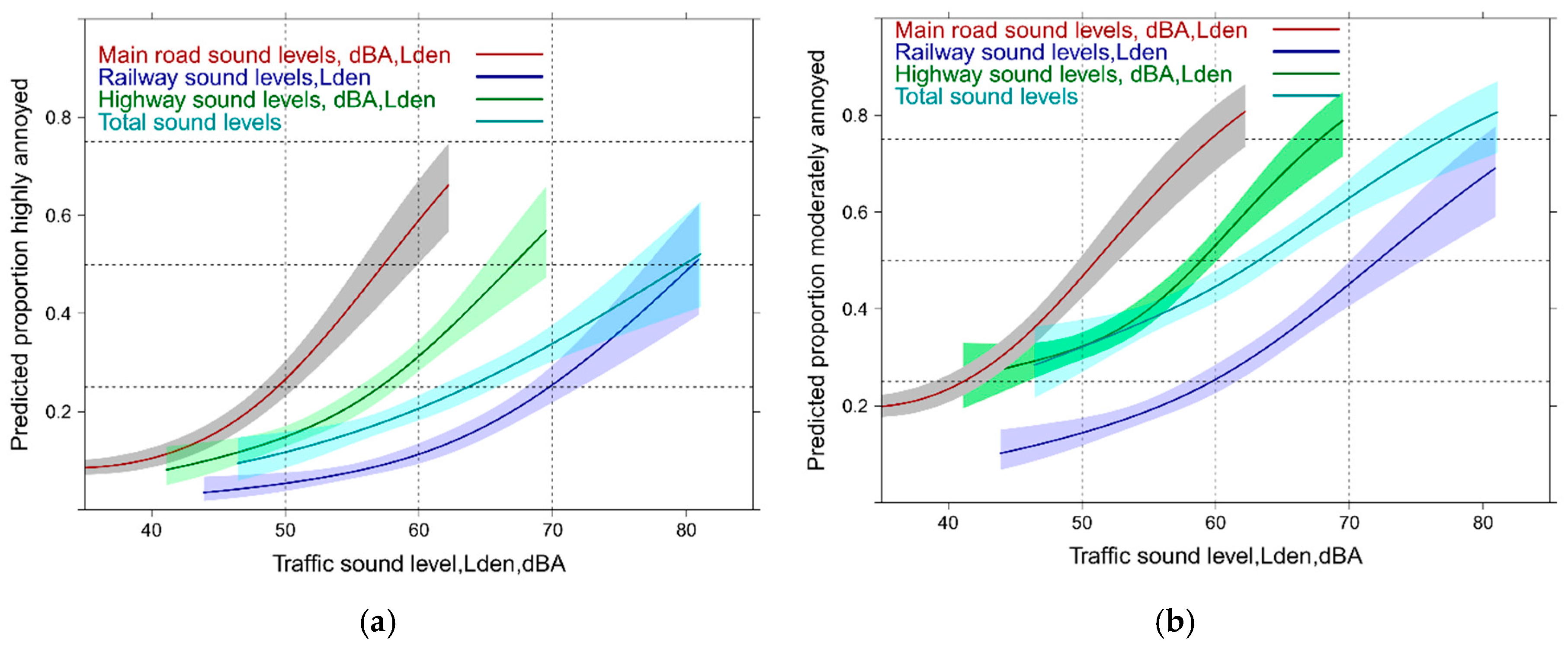


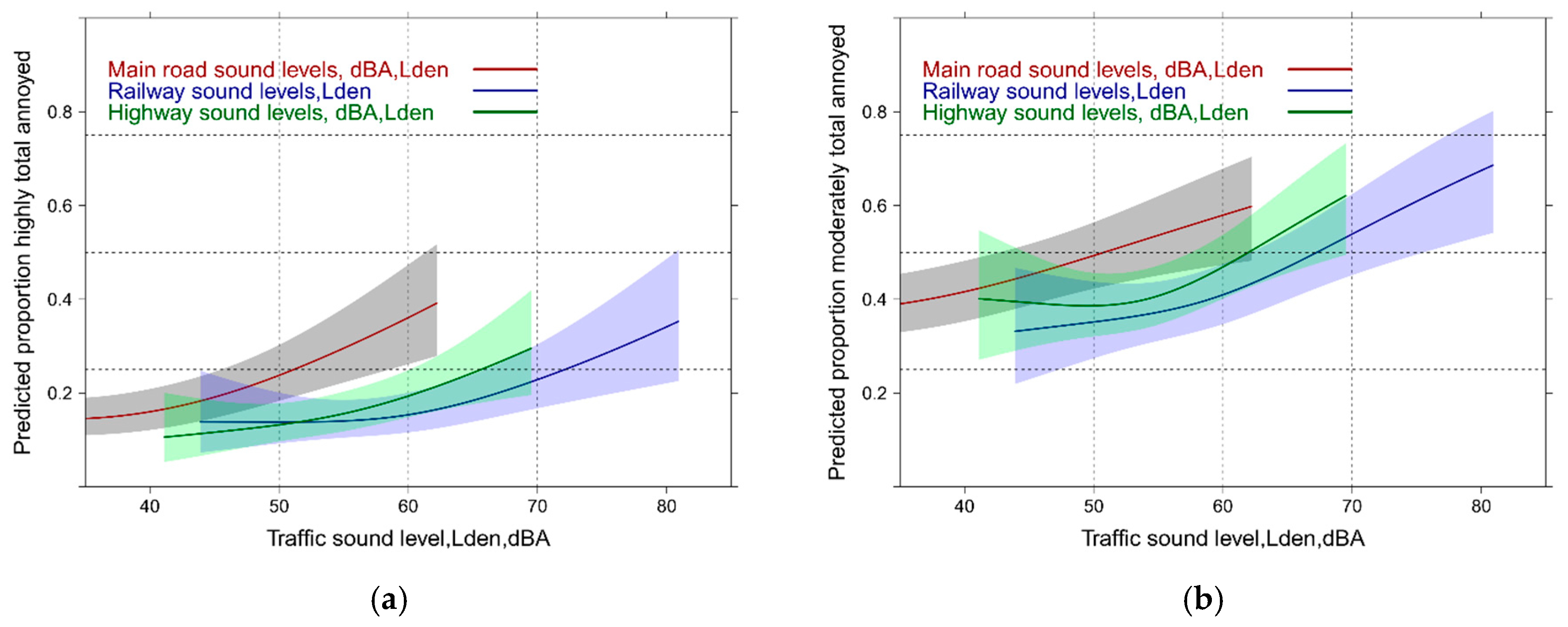

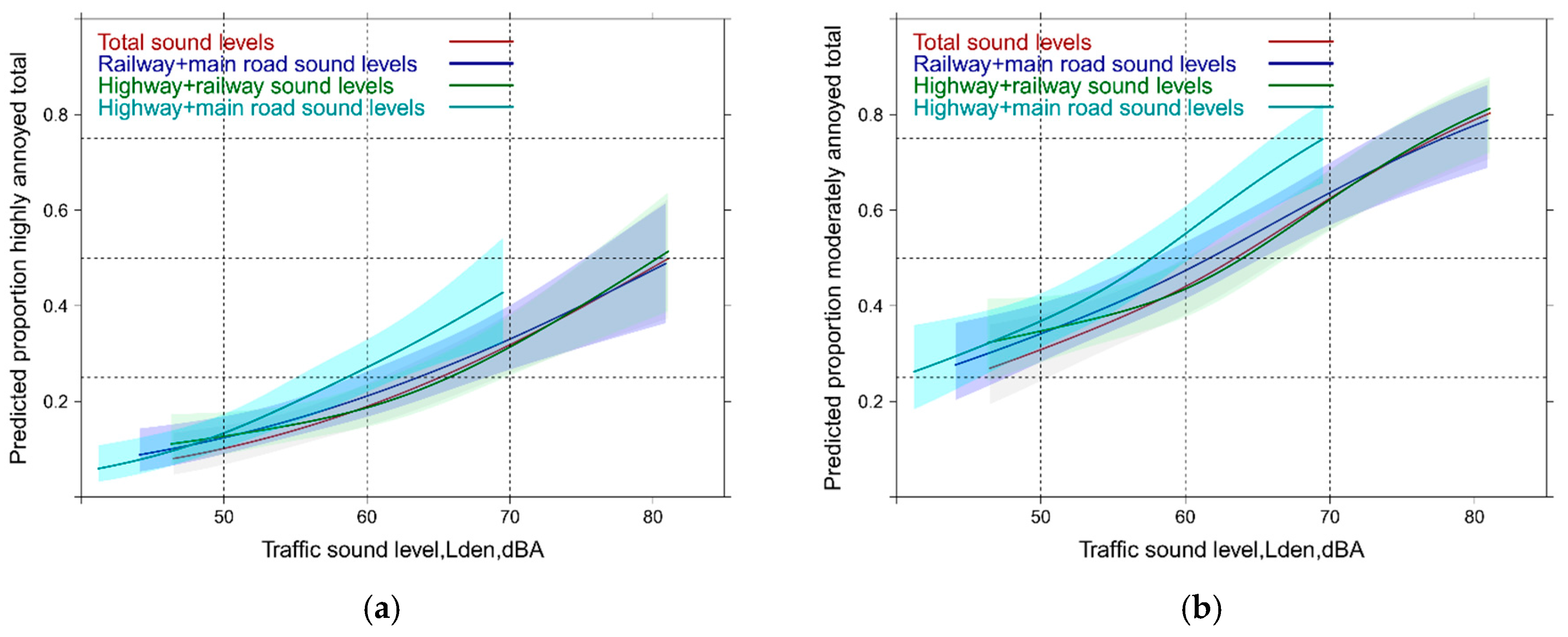


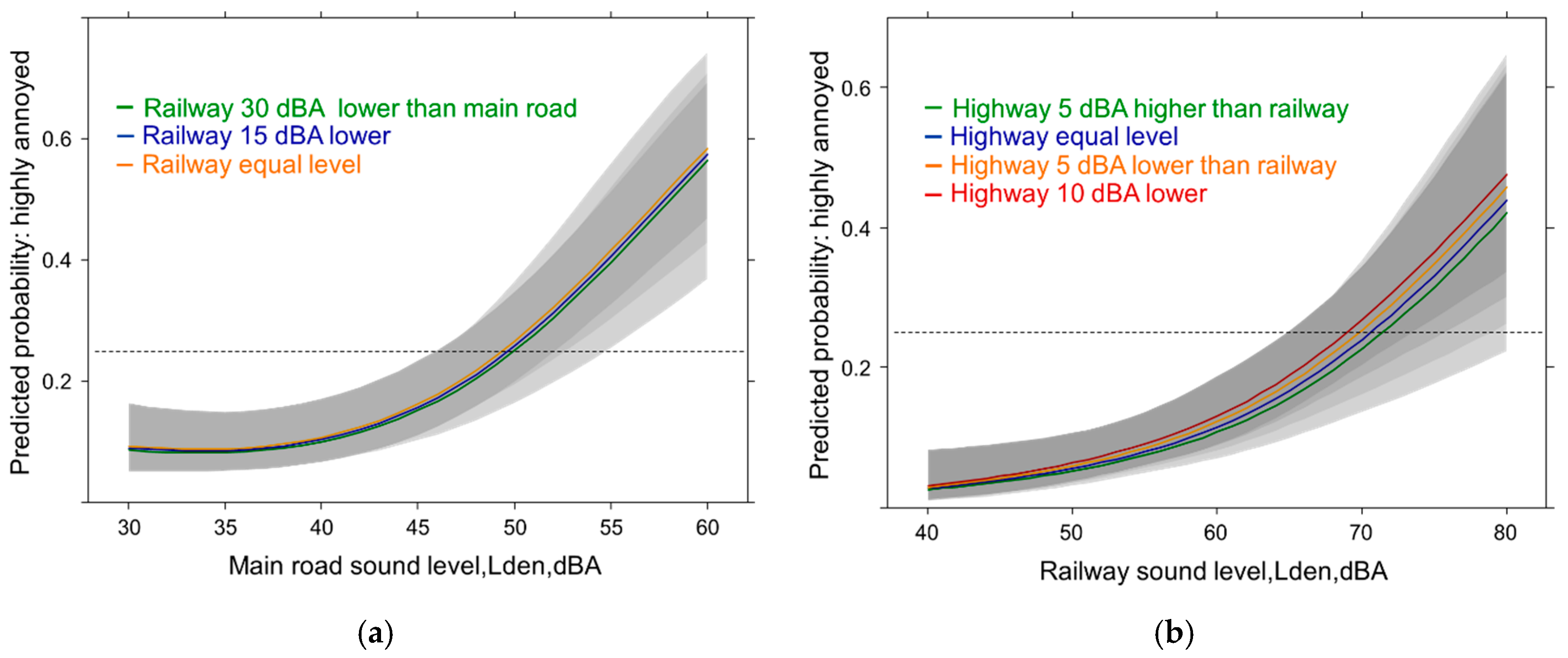
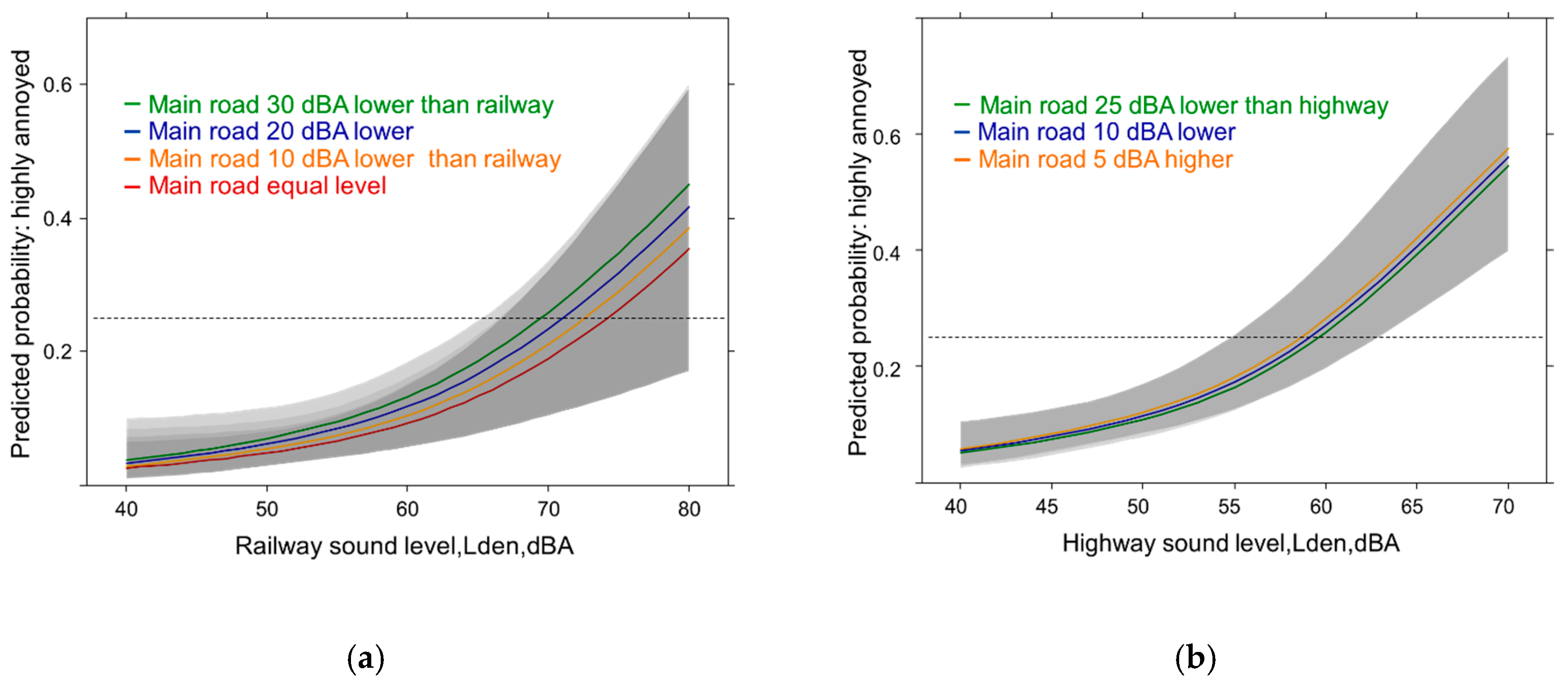
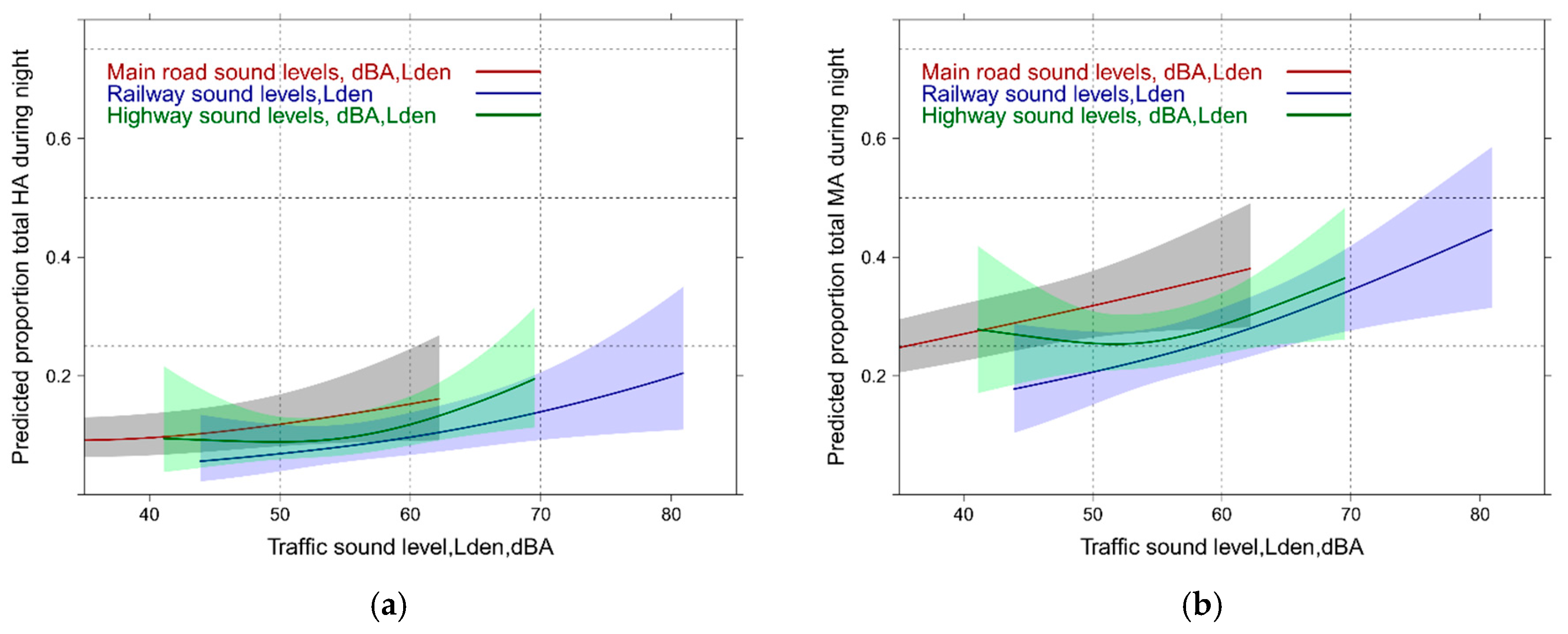
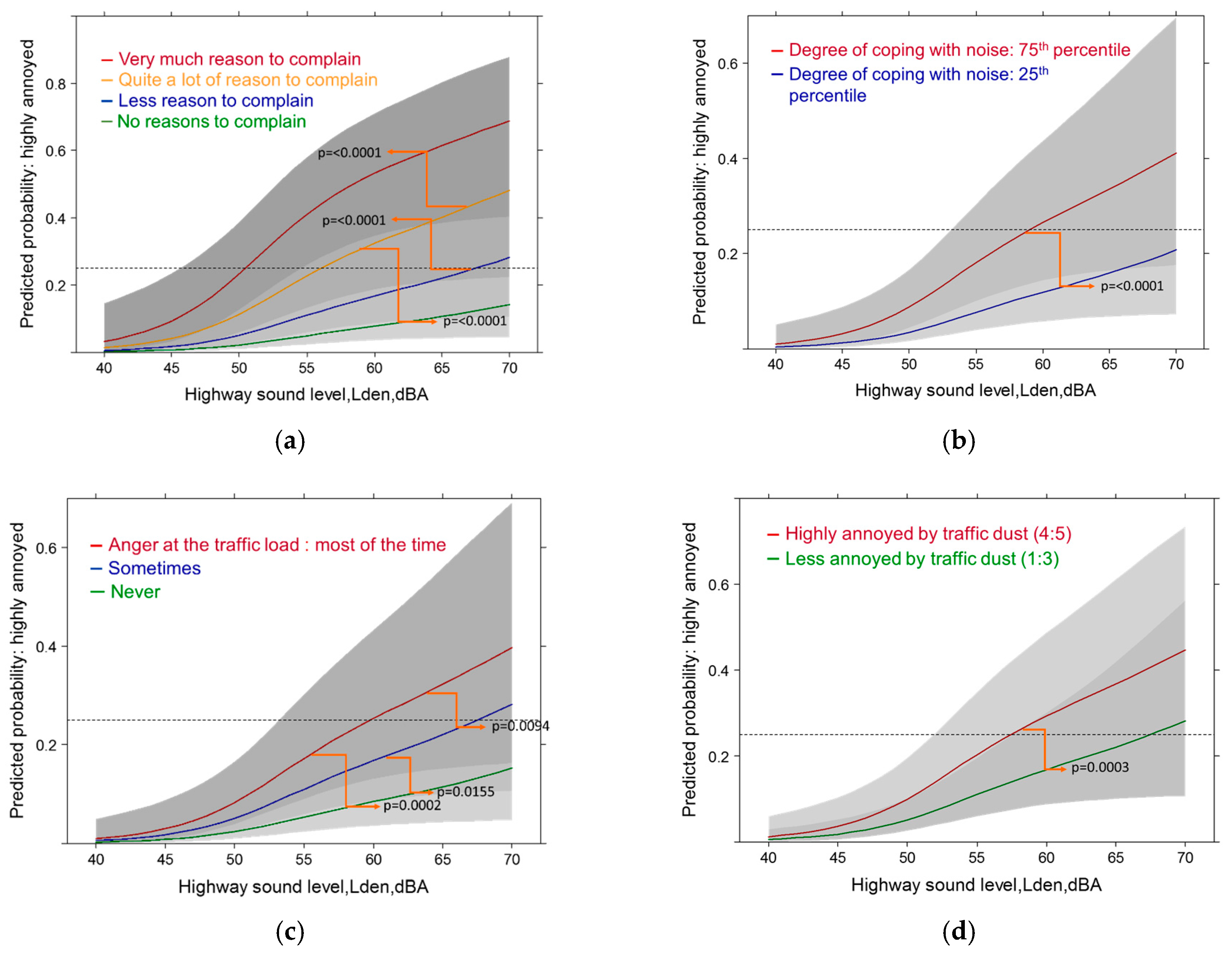

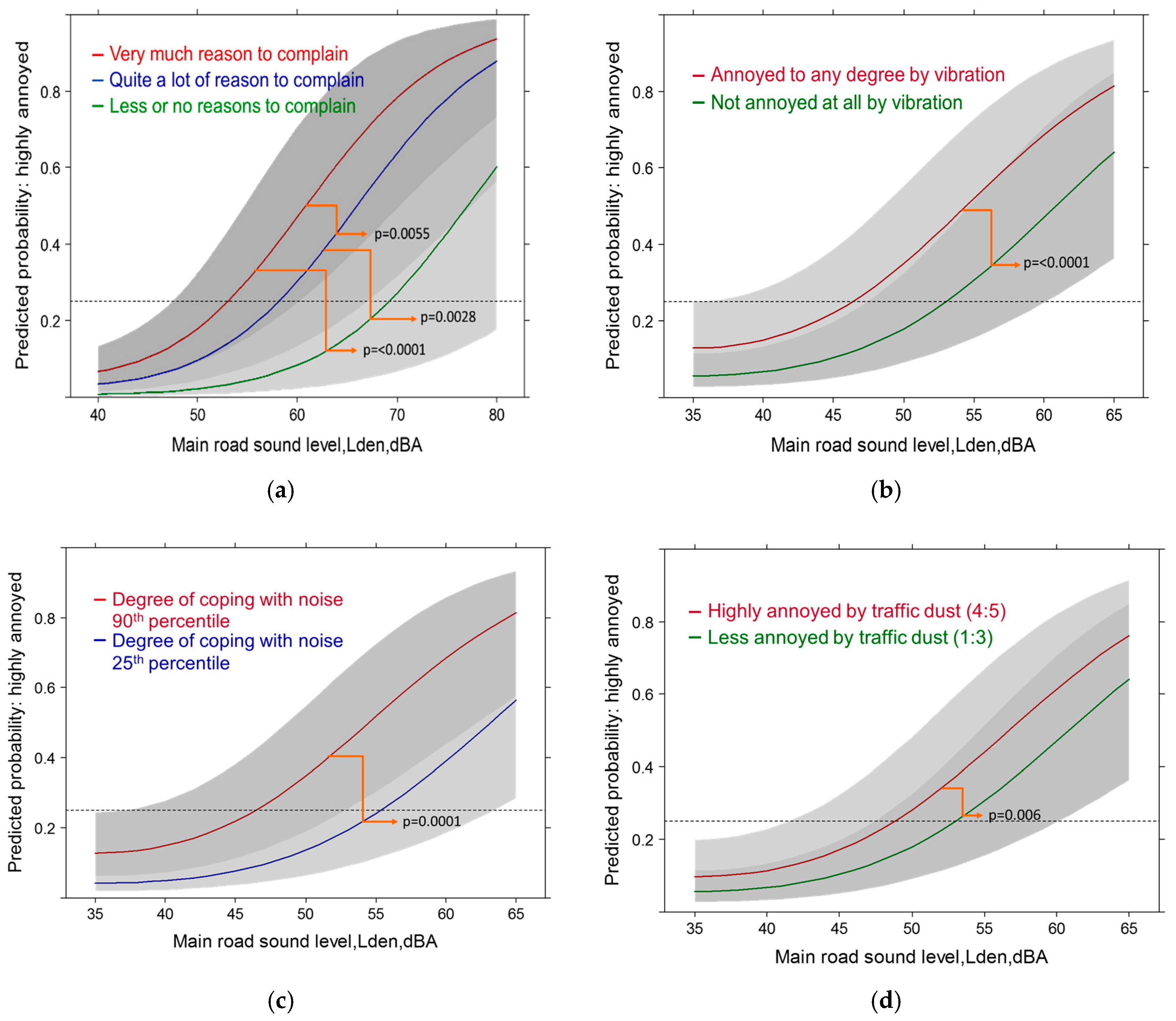
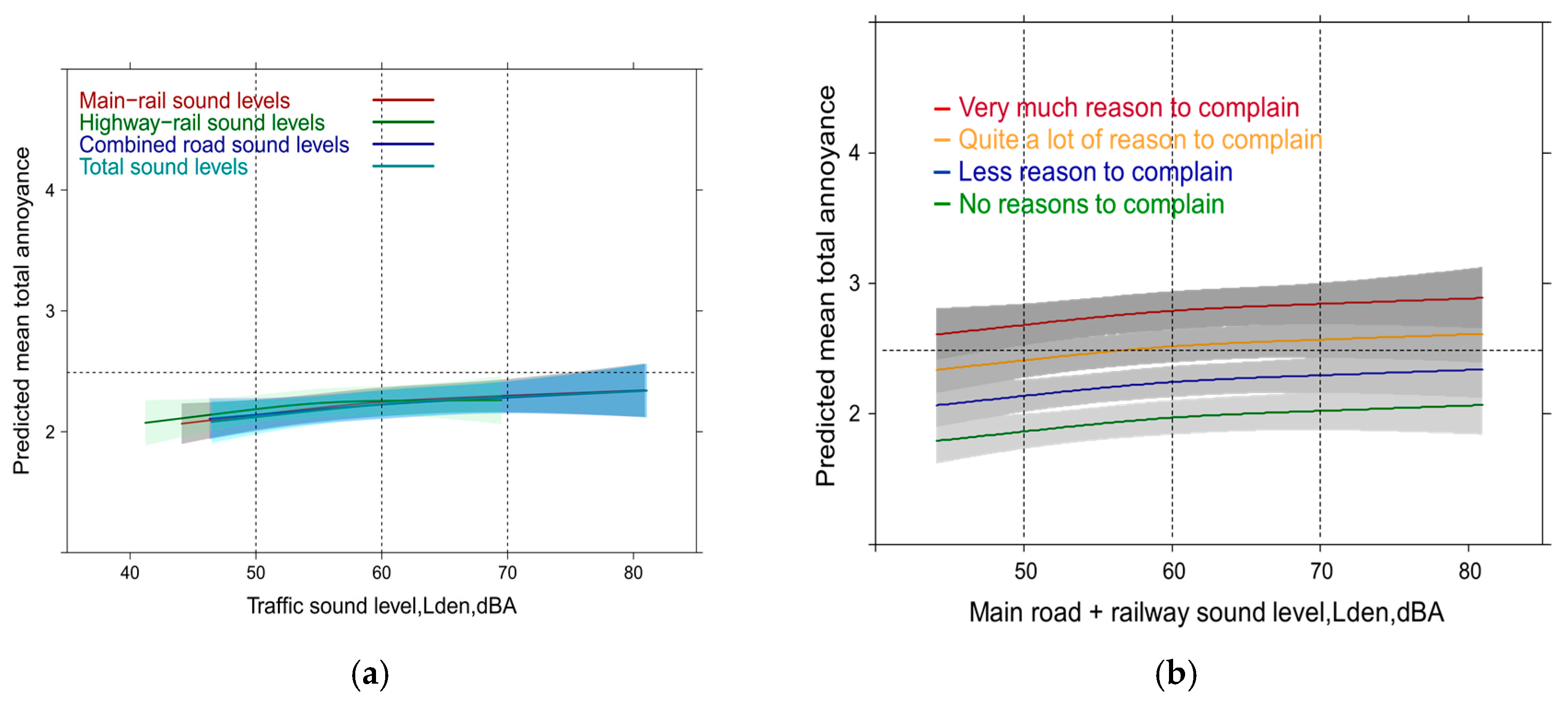
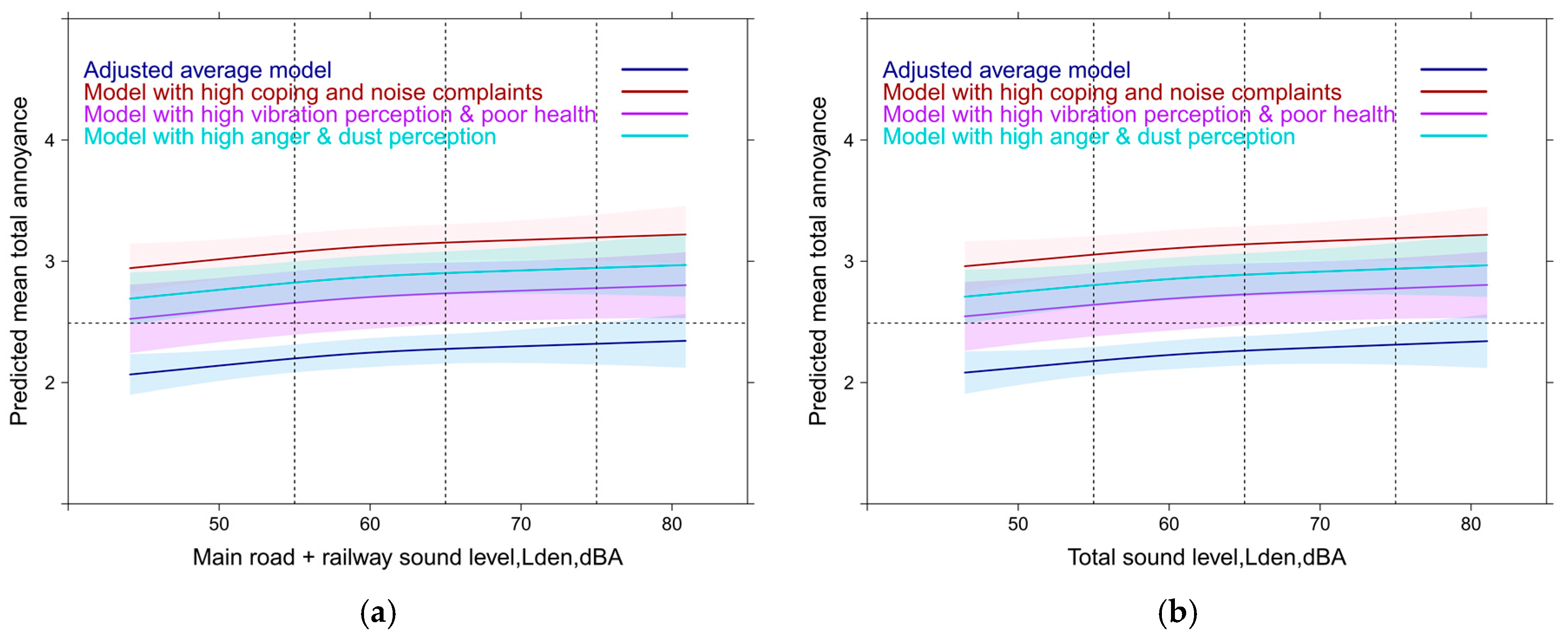
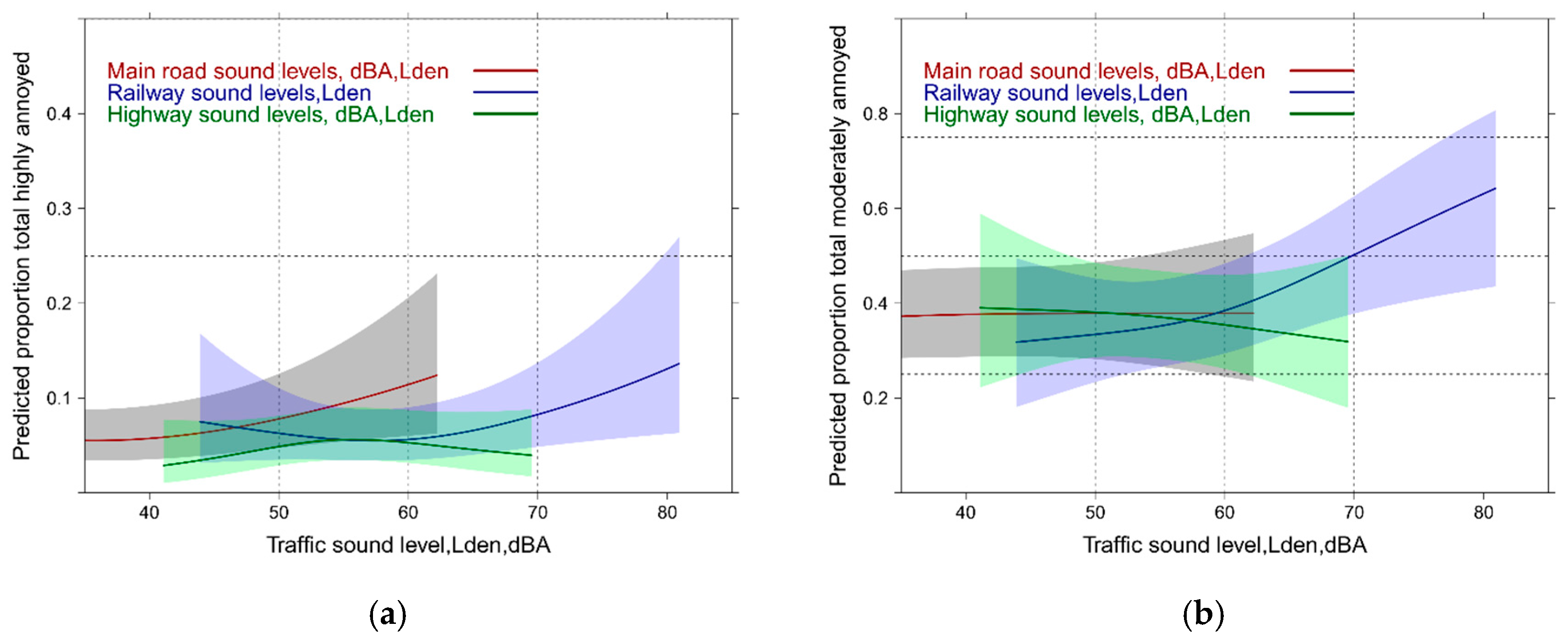
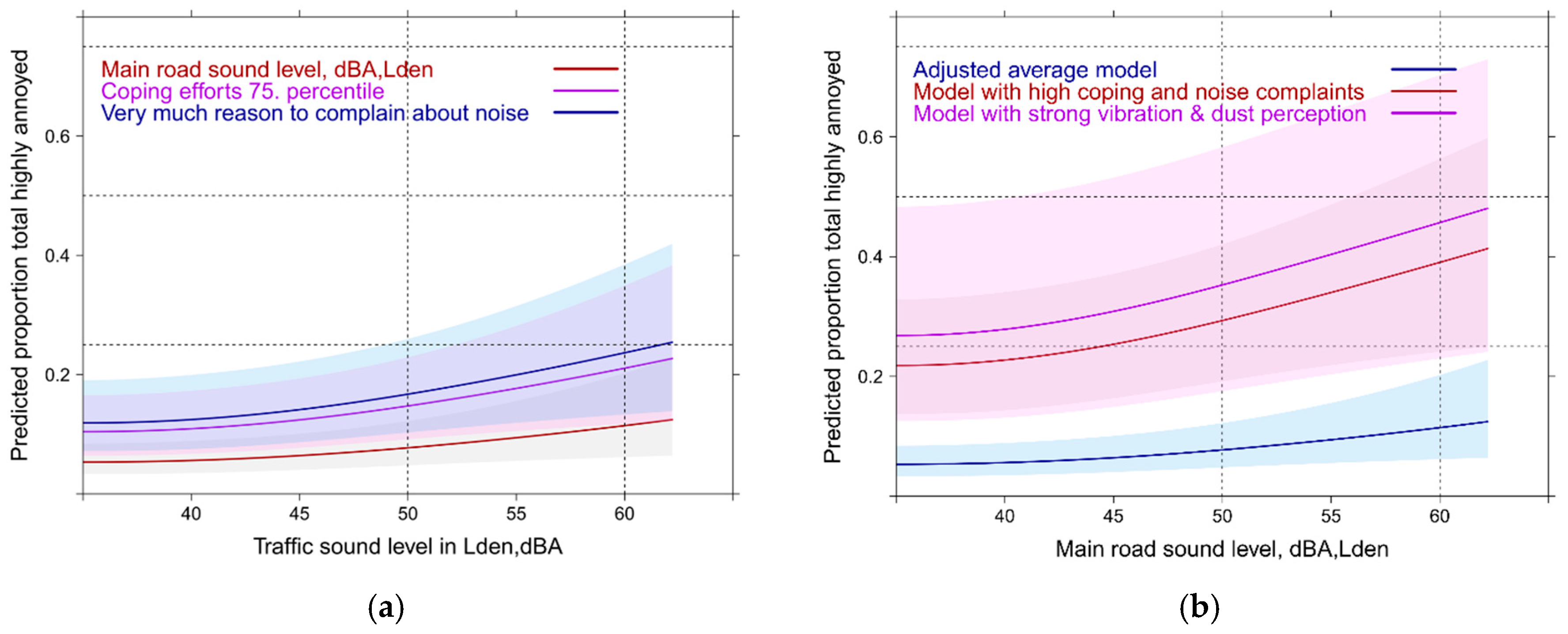
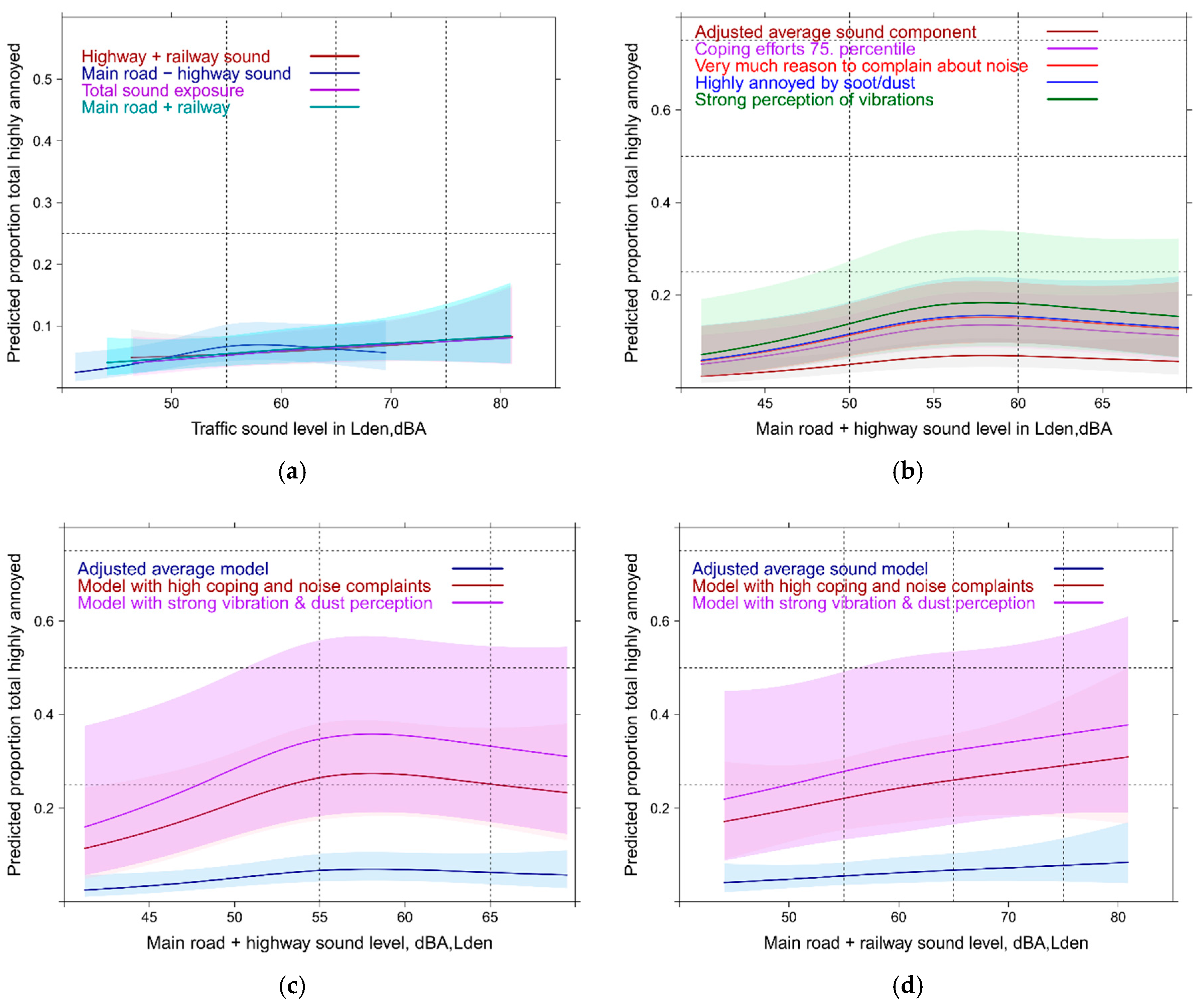
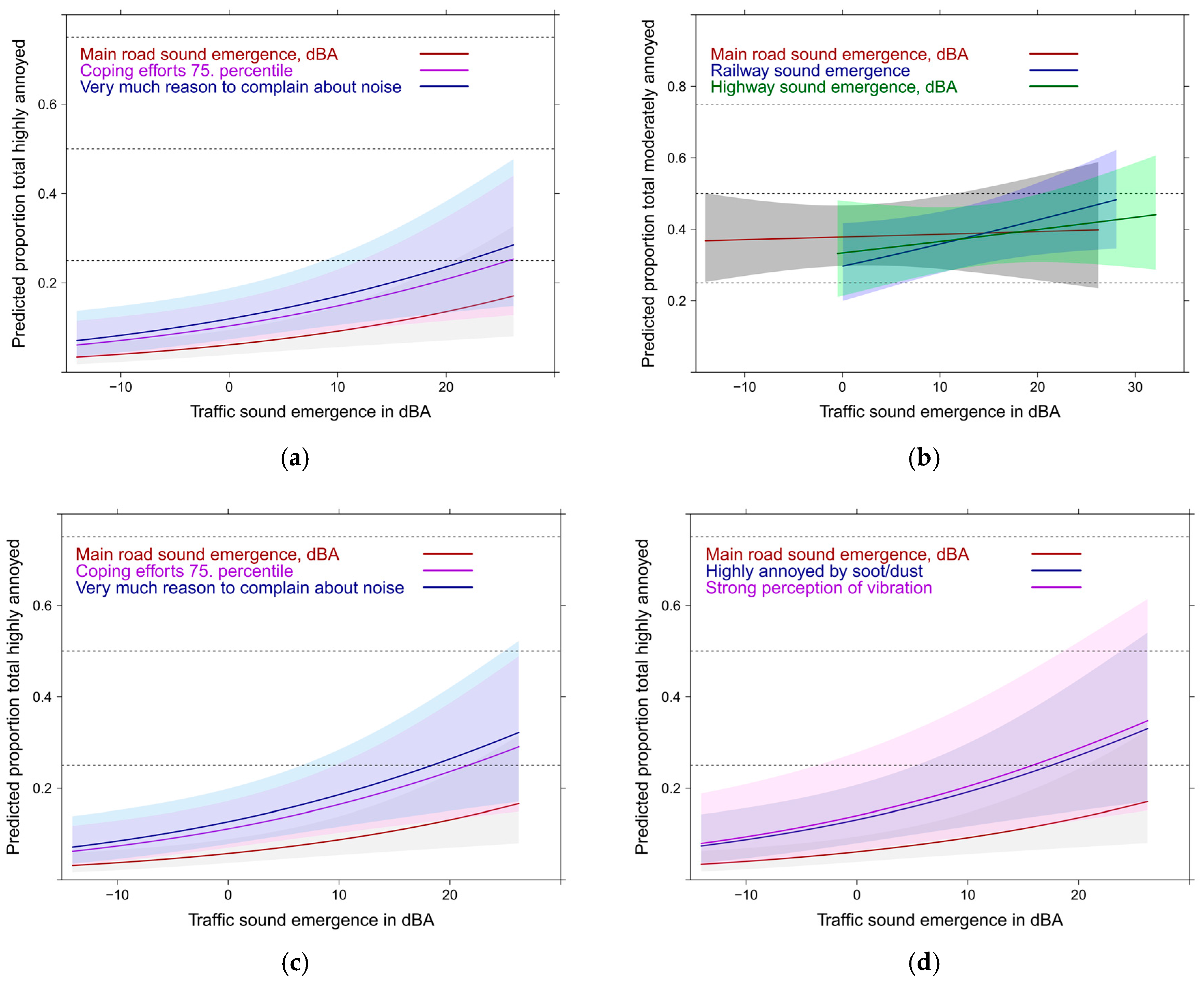

| Categorical | Total Noise Annoyance * | Sample Size | Test Statistic | ||
|---|---|---|---|---|---|
| Variables | Low, n (%) | High, n (%) | Total, n (%) | df—Chi-Square | p-Value |
| Full sample | 1264 (77.0) | 377 (23.0) | 1641 (100.0) | ||
| Age (years) | Chisq. (4 df) = 17.24 | 0.002 | |||
| 25–34 | 211 (16.7) | 45 (11.9) | 256 (15.6) | ||
| 35–44 | 341 (27) | 123 (32.6) | 464 (28.3) | ||
| 45–54 | 303 (24) | 88 (23.3) | 391 (23.8) | ||
| 55–64 | 208 (16.5) | 81 (21.5) | 289 (17.6) | ||
| 65+ | 201 (15.9) | 40 (10.6) | 241 (14.7) | ||
| Gender | Chisq. (1 df) = 0.03 | 0.86 | |||
| Male | 488 (38.6) | 143 (37.9) | 631 (38.5) | ||
| Female | 776 (61.4) | 234 (62.1) | 1010 (61.5) | ||
| Education | Chisq. (3 df) = 9.83 | 0.02 | |||
| Basic | 211 (16.7) | 53 (14.1) | 264 (16.1) | ||
| Skilled | 337 (26.7) | 84 (22.4) | 421 (25.7) | ||
| Vocational | 310 (24.6) | 121 (32.3) | 431 (26.4) | ||
| Higher | 402 (31.9) | 117 (31.2) | 519 (31.7) | ||
| Health status | Chisq. (2 df) = 24.26 | <0.001 | |||
| Excellent | 386 (30.5) | 74 (19.6) | 460 (28) | ||
| Good | 449 (35.5) | 129 (34.2) | 578 (35.2) | ||
| Poor | 429 (33.9) | 174 (46.2) | 603 (36.7) | ||
| Noise sensitivity | Chisq. (1 df) = 48.14 | <0.001 | |||
| High | 158 (12.5) | 104 (27.6) | 262 (16) | ||
| Low | 1106 (87.5) | 273 (72.4) | 1379 (84) | ||
| Air pollution sensitivity | Chisq. (1 df) = 89.14 | <0.001 | |||
| High | 230 (18.2) | 158 (41.9) | 388 (23.6) | ||
| Low | 1034 (81.8) | 219 (58.1) | 1253 (76.4) | ||
| Annoyance by dust/soot | Chisq. (1 df) = 340.57 | <0.001 | |||
| Highly annoyed | 139 (11) | 209 (55.4) | 348 (21.2) | ||
| Less annoyed | 1125 (89) | 168 (44.6) | 1293 (78.8) | ||
| Annoyance by traffic exhaust | Chisq. (1 df) = 247.12 | <0.001 | |||
| Highly annoyed | 55 (4.4) | 126 (33.4) | 181 (11) | ||
| Less annoyed | 1209 (95.6) | 251 (66.6) | 1460 (89) | ||
| Annoyance by vibration: roads | Chisq. (1 df) = 87.61 | <0.001 | |||
| Annoyed | 171 (13.5) | 132 (35) | 303 (18.5) | ||
| Not annoyed | 1093 (86.5) | 245 (65) | 1338 (81.5) | ||
| Annoyance by vibration: railway | Chisq. (1 df) = 33.89 | <0.001 | |||
| Annoyed | 119 (9.4) | 78 (20.7) | 197 (12) | ||
| Not annoyed | 1145 (90.6) | 299 (79.3) | 1444 (88) | ||
| Area complaints: noise pollution | Chisq. (2 df) = 300.03 | <0.001 | |||
| Less or no reasons to complain | 426 (33.7) | 23 (6.1) | 449 (27.4) | ||
| Quite a lot of reason to complain | 422 (33.4) | 40 (10.6) | 462 (28.2) | ||
| Very much reason to complain | 416 (32.9) | 314 (83.3) | 730 (44.5) | ||
| Area complaints: air pollution | Chisq. (2 df) = 205.83 | <0.001 | |||
| Less or no reasons to complain | 431 (34.1) | 30 (8) | 461 (28.1) | ||
| Quite a lot of reason to complain | 389 (30.8) | 59 (15.6) | 448 (27.3) | ||
| Very much reason to complain | 444 (35.1) | 288 (76.4) | 732 (44.6) | ||
| Anger towards traffic load | Chisq. (2 df) = 430.49 | <0.001 | |||
| Never | 502 (39.7) | 17 (4.5) | 519 (31.6) | ||
| Sometimes | 527 (41.7) | 81 (21.5) | 608 (37.1) | ||
| Mostly | 235 (18.6) | 279 (74) | 514 (31.3) | ||
| Helpless towards traffic load | Chisq. (2 df) = 201.41 | <0.001 | |||
| Never | 580 (45.9) | 52 (13.8) | 632 (38.5) | ||
| Sometimes | 364 (28.8) | 88 (23.3) | 452 (27.5) | ||
| Mostly | 320 (25.3) | 237 (62.9) | 557 (33.9) | ||
| Housing: type | Chisq. (2 df) = 5.88 | 0.053 | |||
| appartment home | 280 (22.2) | 64 (17) | 344 (21) | ||
| row house | 274 (21.7) | 97 (25.7) | 371 (22.6) | ||
| single detached home | 710 (56.2) | 216 (57.3) | 926 (56.4) | ||
| Geographic area features | Chisq. (2 df) = 11.01 | 0.004 | |||
| rural | 340 (26.9) | 90 (23.9) | 430 (26.2) | ||
| suburban | 445 (35.2) | 168 (44.6) | 613 (37.4) | ||
| urban | 479 (37.9) | 119 (31.6) | 598 (36.4) | ||
| Traffic exposure situation: home | Chisq. (4 df) = 50.02 | <0.001 | |||
| Highway within 200 m | 112 (8.9) | 58 (15.4) | 170 (10.4) | ||
| Railway within 200 m | 148 (11.7) | 74 (19.6) | 222 (13.5) | ||
| Main road within 100 m | 163 (12.9) | 58 (15.4) | 221 (13.5) | ||
| Mixed traffic | 31 (2.5) | 18 (4.8) | 49 (3) | ||
| Outside above areas | 810 (64.1) | 169 (44.8) | 979 (59.7) | ||
| Annoyance by highway | Chisq. (1 df) = 485.3 | <0.001 | |||
| low | 1137 (90) | 135 (35.8) | 1272 (77.5) | ||
| high | 127 (10) | 242 (64.2) | 369 (22.5) | ||
| Annoyance by local road | Chisq. (1 df) = 230.56 | <0.001 | |||
| high | 1168 (92.4) | 228 (60.5) | 1396 (85.1) | ||
| low | 96 (7.6) | 149 (39.5) | 245 (14.9) | ||
| Annoyance by railway | Chisq. (1 df) = 193.83 | <0.001 | |||
| low | 1182 (93.5) | 249 (66) | 1431 (87.2) | ||
| high | 82 (6.5) | 128 (34) | 210 (12.8) | ||
| Continuous Variables | Total Noise Annoyance * | Sample | Test Statistic | p-Value | |
|---|---|---|---|---|---|
| Low (Median, IQR) | High (Median, IQR) | Total, (Median, IQR) | t-Test (df = 1) | ||
| Sound level highway * | F = 44.67 | <0.001 | |||
| Median (IQR) | 53.2 (49.1, 57.8) | 56.4 (51.1,60.7) | 53.7 (49.6,58.6) | ||
| Sound level railway * | F = 45.54 | <0.001 | |||
| Median (IQR) | 58 (52.4,62.8) | 61 (54.9,66.9) | 58.7 (52.9,63.9) | ||
| Sound level main roads * | F = 16.98 | <0.001 | |||
| Median (IQR) | 36.4 (31.3,42.2) | 37.8 (33.1,46.5) | 36.7 (31.7,43) | ||
| Sound level all sources * | F = 64.63 | <0.001 | |||
| Median (IQR) | 59.9 (54.9,64.5) | 63 (58.4,68.7) | 60.6 (55.5,65.7) | ||
| Duration of living at home: yrs | F = 1.95 | 0.163 | |||
| Median (IQR) | 16 (7,30) | 17 (8,32) | 16 (7,31) | ||
| Annual NO2 level, µg/m³ | F = 31.93 | <0.001 | |||
| Median (IQR) | 27.8 (24.8,31.3) | 29.3 (26.1,34.2) | 28.1 (25.1,32.1) | ||
| Distance to highway: m | F = 50.75 | <0.001 | |||
| Median (IQR) | 687.8 (385.1,1020.9) | 487.3 (261.6,808.2) | 631.6 (346.7,974.9) | ||
| Distance to main road: m | F = 3.26 | 0.071 | |||
| Median (IQR) | 539.1 (182.5,947.4) | 660.6 (191.2,1143.5) | 560.6 (182.5,967.6) | ||
| Distance to railway: m | F = 42.41 | <0.001 | |||
| Median (IQR) | 681.9 (405.5,1033.6) | 521 (259,787) | 638 (372.5,974.9) | ||
| Life satisfaction score+ | F = 36.17 | <0.001 | |||
| Median (IQR) | 30 (26,32) | 28 (24,31) | 29 (26,32) | ||
| Sleep disturbance score # | F = 79.4 | <0.001 | |||
| Median (IQR) | 7 (5,10) | 9 (7,13) | 8 (5,11) | ||
| Coping efforts score $ | F = 700.9 | <0.001 | |||
| Median (IQR) | 22 (17,29) | 40 (32,47) | 25 (18,35) | ||
| Source Model | Wald Chi-Square | df | p-Value |
|---|---|---|---|
| Highway-model * | |||
| Dust/soot high | 12.93 | 1 | 0.0003 |
| Vibration high | 0.63 | 1 | 0.4266 |
| Railway-model * | |||
| Dust/soot high | 0.01 | 1 | 0.9299 |
| Vibration high | 11.05 | 1 | 0.0009 |
| Main road-model * | |||
| Dust/soot high | 7.12 | 1 | 0.0076 |
| Vibration high | 18.96 | 1 | <0.0001 |
© 2017 by the authors. Licensee MDPI, Basel, Switzerland. This article is an open access article distributed under the terms and conditions of the Creative Commons Attribution (CC BY) license (http://creativecommons.org/licenses/by/4.0/).
Share and Cite
Lercher, P.; De Coensel, B.; Dekonink, L.; Botteldooren, D. Community Response to Multiple Sound Sources: Integrating Acoustic and Contextual Approaches in the Analysis. Int. J. Environ. Res. Public Health 2017, 14, 663. https://doi.org/10.3390/ijerph14060663
Lercher P, De Coensel B, Dekonink L, Botteldooren D. Community Response to Multiple Sound Sources: Integrating Acoustic and Contextual Approaches in the Analysis. International Journal of Environmental Research and Public Health. 2017; 14(6):663. https://doi.org/10.3390/ijerph14060663
Chicago/Turabian StyleLercher, Peter, Bert De Coensel, Luc Dekonink, and Dick Botteldooren. 2017. "Community Response to Multiple Sound Sources: Integrating Acoustic and Contextual Approaches in the Analysis" International Journal of Environmental Research and Public Health 14, no. 6: 663. https://doi.org/10.3390/ijerph14060663






